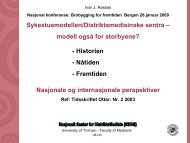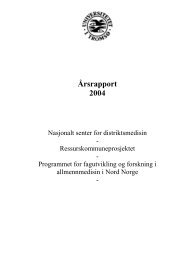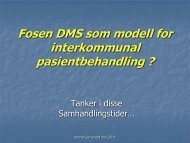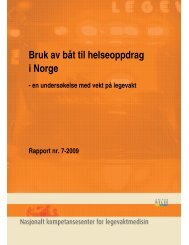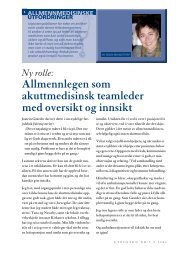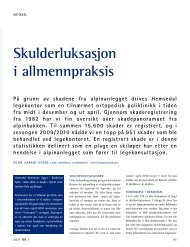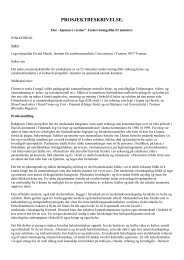Helge Garåsen The Trondheim Model - NSDM
Helge Garåsen The Trondheim Model - NSDM
Helge Garåsen The Trondheim Model - NSDM
Create successful ePaper yourself
Turn your PDF publications into a flip-book with our unique Google optimized e-Paper software.
BMC Health Services Research 2007, 7:133<br />
http://www.biomedcentral.com/1472-6963/7/133<br />
1). Descriptions of the patients' social network and need<br />
for home care were assessed to be of low quality in 92%<br />
and 88% of the referral letters.<br />
<strong>The</strong> quality of the referral letters were assessed to be insufficient<br />
independent of who referred the patients; general<br />
practitioners, emergency personals or physicians at outpatient<br />
departments.<br />
Discharge letters<br />
<strong>The</strong> discharge letters were written by 94 different physicians.<br />
Information about the actual medical situation was<br />
assessed to be of high quality in 96%, of medical history<br />
in 92%, of symptoms in 60%, of signs in 55%, of medication<br />
in 82% and of ADL in 50% of the discharge letters<br />
(Table 2). However, the descriptions of social network<br />
(20%) and the need for home care (31%) were denoted to<br />
be of high quality in fewer cases (Table 2).<br />
As much as 20% of discharge letters were missing vital<br />
medical information and almost none described ADL or<br />
patients' need for home care services.<br />
Benefit of general hospital care<br />
<strong>The</strong> assessments showed that the specialists meant that<br />
general hospital care had a large beneficial value for 77%<br />
of the patients, nurses scored 71% and general practitioners<br />
59%. <strong>The</strong> score for all the panellists combined was<br />
70% (Table 3). Consensus regarding benefit of the admissions<br />
was fair between the panels, but varied from poor to<br />
good within the panels and between the professions; with<br />
a much higher degree of consensus between the specialists<br />
(κ = 0.64) than the other professions. Within the panels<br />
there was an especially large disagreement as to the benefit<br />
of general hospital care between the specialist and the<br />
general practitioner in one of the panels (B) (κ = 0.04).<br />
In the present study there were no statistically significant<br />
associations between the quality of the referral and discharge<br />
letters and the assessments of the benefit of the<br />
general hospital care, except for ADL. A good description<br />
of ADL, however, was strongly associated with a high benefit<br />
of general hospital care (p < 0.001).<br />
Follow-up responsibility after discharge<br />
Some one of four discharge letters had no information as<br />
to who was responsible for follow-up care. Fifty-three of<br />
the patients were to be followed-up by general practitioners,<br />
17 at outpatient departments at the general hospital,<br />
two at a nursing home, 28 needed public home care services<br />
and 23 discharge letters had no information about<br />
follow-up responsibility.<br />
Where could patients have been treated instead of being<br />
admitted to the general hospital<br />
<strong>The</strong>re was consensus within the expert panels that several<br />
patients could have been treated without a general hospital<br />
admission. Three of the patients could have received<br />
sufficient care from general practitioners, five by home<br />
care providers and eight at outpatient departments at a<br />
community hospital. More patients treated at the cardiological<br />
department (15% of the patients) could have been<br />
treated at outpatient departments than at the other departments.<br />
However, more patients from pulmonary (26.7%)<br />
and orthopaedic (23.3%) departments could have been<br />
treated at a community hospital than patients from the<br />
cardiological department (2.5%); a statistically significant<br />
difference (p = 0.001). <strong>The</strong> nurses (28 patients) and the<br />
general practitioners (18 patients) assessed that more<br />
patients could have been treated at a community hospital<br />
than the specialists (15 patients).<br />
Consensus between the expert panels, within panels and<br />
between the professions<br />
<strong>The</strong> consensus between the panels, and within the panels<br />
and between the panellists, was very good when assessing<br />
information about the actual medical situation and<br />
former medical history (Table 4, Figure 1). We found very<br />
good agreement on medication (κ = 1.00) between the<br />
panels and from moderate to very good consensus<br />
between the same professions and within the panels.<br />
When assessing symptoms, signs, social network and need<br />
for home care, there was poor consensus between the panels<br />
and from poor (none) to moderate within the panels<br />
and within the same professions. Assessing ADL, we<br />
found a fair consensus between the panels and from poor<br />
Table 2: Assessments (with 95% Confidence Intervals) of the quality of the discharge letters (N = 100)<br />
Low Intermediate High Mean score<br />
Actual situation 1 (0–5) 3 96 (90–99) 7.29 (7.10–7.48)<br />
Former medical history 5 (2–11) 3 92 (85–97) 6.84 (6.56–7.12)<br />
Symptoms 28 (24–32) 12 60 (51–69) 5.30 (4.86–5.74)<br />
Signs 31 (22–41) 14 55 (45–65) 5.14 (4.70–5.58)<br />
Medication 12 (7–20) 6 82 (73–89) 6.93 (6.47–7.40)<br />
ADL 16 (9–25) 34 50 (40–60) 5.35 (5.02–5.68)<br />
Social network 80 (71–87) 0 20 (13–29) 1.20 (1.12–1.28)<br />
Need of care 69 (59–78) 0 31 (22–41 1.87 (1.73–2.00)<br />
Page 4 of 7<br />
(page number not for citation purposes)



